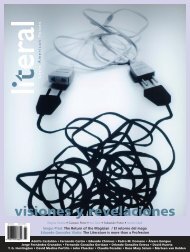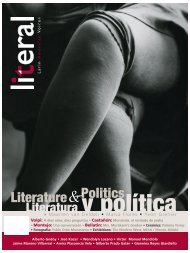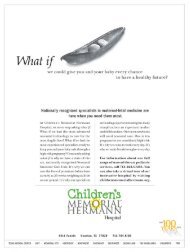Giobany Arévalo > Gabriela Torres Olivares >Anuar Jalife - Literal
Giobany Arévalo > Gabriela Torres Olivares >Anuar Jalife - Literal
Giobany Arévalo > Gabriela Torres Olivares >Anuar Jalife - Literal
You also want an ePaper? Increase the reach of your titles
YUMPU automatically turns print PDFs into web optimized ePapers that Google loves.
LIBROS BOOKS CD RECORDS<br />
máquina del tiempo rellenar de imaginación<br />
el prodigio de la ciencia, en una época de<br />
grandes inventos. Félix J. Palma ha recreado<br />
algunos de los momentos históricos que reproducían<br />
los periódicos de la época: los asesinatos<br />
de Jack, el Destripador o la doble vida<br />
de Jekyll y Hyde, pero sobre todo consigue<br />
una maravillosa recreación de la época victoriana,<br />
con las invenciones de Wells como<br />
trasfondo.<br />
La novela se estructura en tres partes<br />
diferenciadas, aunque con un denominador<br />
común, los viajes temporales, la posibilidad<br />
de cambiar el curso de la historia, el sueño<br />
que Wells inventó literariamente, y que Palma<br />
desarrolla en su novela, protagonizada<br />
en buena parte por el escritor británico: en<br />
la primera Andrew Harrington recurre al conocido<br />
Wells porque pretende viajar ocho<br />
años atrás para adelantarse el asesinato de<br />
Mary Jane Kelly, la prostituta asesinada por<br />
el Destripador en el barrio de Whitechapel,<br />
y de la que el joven aristócrata está enamorado;<br />
en la segunda parte, la más literaria y<br />
sorprendente, se relatan los viajes a través de<br />
la empresa de Viajes Temporales Murray, paradojas<br />
temporales sin realizar esa inmersión,<br />
en la que se cuenta una auténtica historia de<br />
amor entre Claire Haggerty con un hombre<br />
del futuro, el capitán Derek Shackleton, un<br />
héroe que salvará al mundo en el año 2000,<br />
y donde se nos da conocer la entrega de toda<br />
una vida al servicio del amor, y como en otros<br />
muchos casos entre una joven distinguida y<br />
un pobre desgraciado que, paradójicamente,<br />
se busca la vida en el mismo plano presente;<br />
y en la tercera, el ingenio del propio Wells se<br />
pondrá a prueba cuando debe esclarecer el<br />
crimen de un hombre que viene del futuro<br />
y pretende arrebatarle la autoría de algunas<br />
de sus novelas. Le ayudarán Conan Doyle y<br />
Stoker, personajes reales, que se suman a la<br />
fi cción y que de alguna manera enlazan las<br />
historias que el gaditano ha ido contando en<br />
las más de seiscientas páginas de El mapa del<br />
tiempo, sin duda, un ejercicio de estilo que<br />
se articula como un auténtico folletín victoriano,<br />
confi gurando en este caso un infi nito<br />
universo paralelo que enlaza con la mejor<br />
tradición literaria anglosajona, elevada en<br />
esta novela a la categoría de maravilla por el<br />
manejo de la introspección en la mente del<br />
escritor, anotando las dudas que asaltan su<br />
existencia y la luz creadora con que maneja<br />
su mejor fi cción.<br />
A CULT CLASSIC<br />
Liliana Valenzuela<br />
Guillermo Rosales,<br />
The Halfway House,<br />
New Directions,<br />
New York, 2009.<br />
Translated by Anna Kushner<br />
Preface by José Manuel<br />
Prieto<br />
To walk into The Halfway House is to inhabit<br />
this particular microcosm of misfi ts somewhere<br />
in Miami, people for whom “nothing<br />
more can be done.” The experience can be<br />
harrowing, and yet, at times, it appears as<br />
though Eros might win over Thanatos. We<br />
follow the life of William Figueras, a Mariel<br />
refugee from Cuba with a history of mental<br />
illness (much like the author himself), as he<br />
descends into this modern day inferno, yet<br />
he’s not crazy, but rather deeply aware of the<br />
abuse and the sordid conditions of his new<br />
“home.” He, who “by the age of fi fteen [had]<br />
read the great Proust, Hesse, Joyce, Miller,<br />
[and] Man” stays afl oat by reading from a<br />
book of English poets, whose poems are peppered<br />
throughout the novel, until he meets<br />
Frances, whose body “while cheated by life,<br />
still has some curves.” She, like Figueras, was<br />
once an enthusiastic young Cuban communist<br />
teaching peasants to read, but has since<br />
become “broken inside.” But Frances is also<br />
an artist, she carries around a folder with her<br />
drawings, “worthless things,” but Figueras is<br />
deeply moved by them and recognizes that<br />
like him, she is redeemed by art. For a moment,<br />
there’s a glimmer of hope as the pair<br />
plots to escape the nut house in order to become<br />
a normal couple, before coming to the<br />
unexpected ending.<br />
The story is told in sparse, lyrical language,<br />
beautifully and accurately rendered<br />
into English by Anna Kushner. The most grotesque<br />
characters are sketched with one or<br />
two quick strokes, yet we feel we know them.<br />
The narrative is further enhanced by Figuera’s<br />
vivid dreams, for instance, his dream of Fidel<br />
in briefs and underwear refusing to leave a<br />
white house, while Figueras shoots at it with<br />
a cannon. The excellent preface by José Ma-<br />
nuel Prieto provides context and proposes<br />
“the condemnation of the ravages of totalitarianism”<br />
as the central theme of the novel.<br />
He also informs us that while this book won<br />
the Letras de Oro (Golden Letters) award in<br />
Mexico in 1987, it was not well received until<br />
reissued in Spain in 2003 under the title of<br />
La casa de los náufragos (The House of the<br />
Shipwrecked) to great acclaim. And that the<br />
2002 French edition published as Mon Ange<br />
(My Angel) “was a resounding success.”<br />
In a little over one hundred pages,<br />
Figueras makes us face the minute moral<br />
calibrations that separate victim from victimizer,<br />
a realization that haunts him, “I regret<br />
having beaten the old one-eyed man. But it’s<br />
too late. I’ve gone from being a witness to<br />
being complicit in what happens in the halfway<br />
house.” A little-known author who destroyed<br />
most of his work before committing<br />
suicide in 1993 at the age of 47, Guillermo<br />
Rosado is deserving of more attention as evidenced<br />
by this intense, raw, little jewel of a<br />
book. The Halfway House has the potential<br />
to become a cult classic on a par with The<br />
Burning Plain, The Kiss of the Spider Woman,<br />
or Pedro and the Captain.<br />
Restos del fuego © Rubé n Echevarrí a<br />
OTOÑO, 2009 LITERAL. VOCES LATINOAMERICANAS 55






